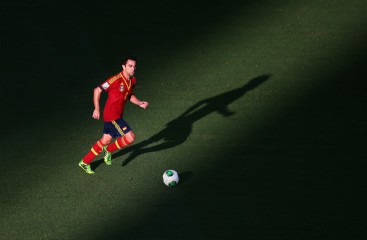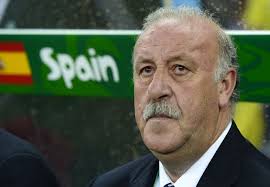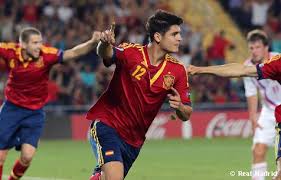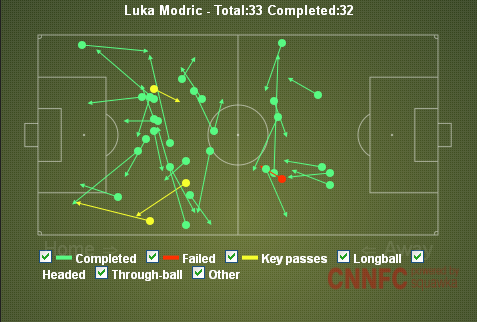Lessons to be Learned?
July 20, 2013 Leave a comment
It’s not like sections of the media to overreact. Is it? Yet that’s precisely what happened recently following events in Brazil. The home side took the Confederations Cup on home soil with as comprehensive a competitive win over the Spanish as there has been for many years. It left del Bosque and La Furia Roja to admit that their period of domination was coming to an end. The Spanish have had a good run. Two European Championships and a World Cup yet the prize upon which you are now seemingly judged, the Confederations Cup, has escaped their clutches twice. Its now back to the drawing board for the Spanish. They must navigate the remainder of their qualifying campaign to claim a place in Brazil next summer but their powers are on the wane already.
Why bother though. The World Cup appears to be a foregone conclusion. Spain won’t win it and it seems a few semi decent performances from Brazil has secured their name upon the trophy. The Seleção have the better of their counterparts. It was a technical and tactical triumph overseen by Scolari.
Wasn’t it?
Brazil Press High And Go Direct
The final against Brazil was notable for two reasons. The style of game that Brazil used against their opponents and the manner in which certain aspects of the Spanish system, whether it be the system itself or components within that system, were problematic.
From the outset of this game, Brazil pressed and harassed Spain high up the pitch in an effort to disrupt their game and prevent them from settling down and finding any rhythm to dictate proceedings. This worked as Spain was slow to move the ball and find space, enabling Brazil to close them down and force misplaced passes.
The question that was apparent from midway through the first half was whether Brazil could sustain the same tempo and level of intensity in their play for the entire game. If the game had been played in the stifling heat and humidity of Fortaleza, this tactic would not have worked. In the cooler, fresher surroundings of Rio, this was an entirely viable tactic.
The pressing succeeded and once Brazil had taken the lead it enabled them to drop deeper on occasion to recover and counter attack Spain. It does highlight the changing face of the Brazilian team at international level. The days of open, flowing football are now long gone. A distant memory consigned to be shown as a montage containing the best World Cup goals ever scored, most probably on BBC3 or ITV2. Primarily a counter attacking team, Brazil struggled to break down opponents who sat deep themselves. Their tactical strategy appears to revolve around getting the ball to Neymar quickly and waiting for something to happen. The midfield lacks creativity and is purely functional, a consequence of the domestic games desire to produce functional defensive midfielders. It wielded a trophy though but Scolari will have taken notice of the stodgy performances that were produced in the process.
For Spain, is the loss important? Yes, if you want to win the Confederations Cup that continues to elude them. More importantly, it provides an opportunity for del Bosque to see what must happen on and off the pitch if Spain is to march to an unprecedented fourth successive international tournament win.
Issues to Confront
This tournament has provided a welcome jolt to remind del Bosque and his players of the challenges that lie ahead in trying to defend their crown in 2014. It’s not just about what happens on the pitch that will decide the World Cup next year but also how you prepare for the tournament itself and how you adapt to the diverse climatic conditions that exist in Brazil.
The tournament will be hosted by a vast country that experiences different conditions dependent upon where you play. The problem for the qualifying sides is the ability to control factors is only partial. Acclimatising to those conditions by arriving early and preparing is within your powers to an extent. Gaining a favourable draw to avoid extensive travelling around the country is not within your powers.
The Spanish must look at the system and the players who are chosen to enable that system to function. Have some vital parts become worn and need replacing?
Does The System Still Work?
Surprisingly, despite the loss to Brazil and the relatively poor performances against Nigeria and Italy, there has been no outbreak of Plan B syndrome in the media. No cries for the ball to be launched high into the air aimlessly. Perhaps after three tournament wins, people are a little more circumspect when considering Spain.
Spain was a little more direct in this tournament. The deployment of a traditional no9 for the games aided this process. Teams have adjusted once more against Spain and now use a mid level block against La Roja in recognition that the sit deep and hope tactic was futile. It provides space behind that Spain can attack but it hinders their build up play in the midfield area. Opponents can close them down quicker in a densely packed area. Spain needed to recycle possession faster and be more direct themselves. Look for the runs in behind the opposing defence but there was a lack of supporting runs from the midfield area during this tournament. The verticality and thrust that was needed never arrived.
There were reasons why it never worked. Fatigue was a constant issue for the side. Only against Uruguay in the opening 45minutes did Spain produce a level of football normally associated with them. Leaving that aside, Spain possesses players with the technical and tactical proficiency to ensure the system is a success.
It needs players to move quickly in midfield, recycling possession. The full backs must push high and offer themselves when the middle of the pitch becomes too congested and the attacking players must be prepared to drive in diagonally between opposing centre backs and full backs to offer the opportunity for through balls. There must be options from the second line of attack. The system is built upon control but that is precisely what Spain lacked. La Roja often looked unsure defensively and opponents able to attack their defence too easily in the central areas. The Spanish possess these qualities but failed to show them.
If the system does work, then it may be the components that need adjusting.
Succession Planning – Life After Xavi
Central to whatever del Bosque chooses will be how Spain adapt to life without Xavi. Its an issue that is vexing Barcelona right now and one to which they appear to have no credible answer.
Xavi is nearing the end of his career and if he continues to play over 60 games per season then the twilight of his career will fade quicker than necessary. Xavi can continue but only if he plays fewer games for club and country. Such a position is only a short-term solution however and Spain must look beyond Xavi and begin the process of reconstructing the midfield. As the lynchpin of the side ages and slows, his passing becomes more horizontal and safer. It lacks penetration and so opponents are safer. The runs into the opposition penalty area decrease. And his ability to track back and share defensive duties pushes his tired limbs too far. Xavi plays within the middle of the pitch. Unable to hurt opponents and unable to stop opponents hurting his team. It leaves Busquets overexposed at one of the pitch and Iniesta lacks someone to share the creative burden for the side. With Alonso to offer greater control, Spain were exposed in the central areas.
The maestro needs time to rest and recuperate. If he receives it, he still has a pivotal role to play for club and country. If he doesn’t then it becomes a real dilemma.
Indeed, when you consider that Iniesta is 29 and has suffered numerous injuries, Xabi Alonso is also the wrong side of 30 then Spain really need to find and identify who will step into the void for all three players. It’s not simply a case of saying “look at all the quality players Spain can choose from”. It’s identifying and saying that these are the players who can step up regularly and claim a starting berth.
Spain has extremely talented midfield players within their U21 squad. The next 12 months must see the process of integrating a few of these players into the senior side.
The likes of Isco, Thaigo and Illarramendi must be called up to the senior squad and enjoy playing time. It will be difficult but crucial to aid their development and Spain’s during this transitional period.
Loyalty: How Far Should It Go?
How Far? One thing that del Bosque has shown time and time again is his loyalty to the players who have delivered for him previously. It could be suggested that the loyalty is partly a result of Spain lacking credible alternatives in a few key positions. The loyalty to Alvaro Arbeloa and Fernando Torres at both the World Cup and European Championships may be questioned but were there really credible alternatives at the previous tournaments?
Who could have replaced Arbeloa at the World Cup? Iraola would have been in the squad were it not for an unfortunate injury whilst Juanfran is more attack minded but lack defensive nous. And does Arbeloa’s more conservative nature not provide greater balance for the team? That was the argument before but the full back offered neither defensive nor attacking qualities in the final. The player’s international career should not hinge upon one poor game but his lack of technical quality on the ball is becoming an issue for Spain on the right. Too much of their thrust comes from the left and the attacking qualities are lop-sided. Is it time to remove Arbeloa from the squad? Azpilicueta is ready and what of Carlos Martinez at Real Sociedad or even Carvejal or Montoya as deputies? The options exist for a more balanced right full back who can attack whilst also providing the defensive solidity required.
At centre back, is it time to remove Raul Albiol from the squad and replace him with Inigo Martinez? The youngster from Sociedad is the future whilst Albiol seldom gets playing time. Make the change now and provide Martinez with 12months to bed in before the World Cup.
Despite the depth of quality within the Spanish ranks, they arguably lack a genuine goalscorer for the No9 jersey. Negredo has had opportunities and now Soldado has been deployed yet neither truly convinces and del Bosque returns to Torres on occasion. Will Torres get playing time at Chelsea under Mourinho?
Is the time right to experiment with an alternative? Could Morata be granted an opportunity if he secures playing time in Madrid? This may seem ludicrous to suggest that a player with such limited playing exposure at Madrid be given a call up to the senior squad but Morata possesses the qualities that the national side lack in attack. He is very direct and moves immediately towards goal. This vertical nature is what Spain needs allied to his aerial ability. He is not some form of panacea to their attacking problems as such but must be considered a real alternative now.
The Return to Brazil
There are flaws present both within the squad and within the system. To ignore these problems would be foolish but just as foolish would be to overestimate the damage they could cause and pretend they are insurmountable.
Vicente del Bosque cannot afford to be too loyal to some of the players who have brought them this far. All great teams enjoy a period of success before their cycle comes to an end. If Spain wishes to prolong their cycle of dominance, some hard choices face the coach. He must not shirk from these but equally he must not overreact. Addressing such matters will not guarantee success next summer but it will provide Spain with the optimum opportunity to succeed but so many other factors will come into play. The Confederations Cup highlighted just how important location will be in Brazil to avoid extremely hot and humid conditions. Arriving in time and acclimatising as well as can be expected will be important.
In 2009, Spain lost to USA 2-0 in South Africa. The European Champions were humbled and their credentials were questioned. Twelve months later they returned to South Africa and claimed the World Cup.
Would you really bet against lighting striking twice?


















